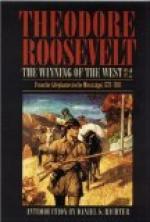Many of these new-comers were “poor whites,” or crackers; lank, sallow, ragged creatures, living in poverty, ignorance, and dirt, who regarded all strangers with suspicion as “outlandish folks.” [Footnote: Smythe’s Tours, I., 103, describes the up-country crackers of North Carolina and Virginia.] With every chance to rise, these people remained mere squalid cumberers of the earth’s surface, a rank, up-country growth, containing within itself the seeds of vicious, idle pauperism, and semi-criminality. They clustered in little groups, scattered throughout the backwoods settlements, in strong contrast to the vigorous and manly people around them.
By far the largest number of the new-comers were of the true, hardy backwoods stock, fitted to grapple with the wilderness and to hew out of it a prosperous commonwealth. The leading settlers began, by thrift and industry, to acquire what in the backwoods passed for wealth. Their horses, cattle, and hogs throve and multiplied. The stumps were grubbed out of the clearings, and different kinds of grains and roots were planted. Wings were added to the houses, and sometimes they were roofed with shingles. The little town of Jonesboro, the first that was not a mere stockaded fort, was laid off midway between the Watauga and the Nolichucky.
As soon as the region grew at all well settled, clergymen began to come in. Here, as elsewhere, most of the frontiersmen who had any religion at all professed the faith of the Scotch-Irish; and the first regular church in this cradle-spot of Tennessee was a Presbyterian log meeting-house, built near Jonesboro in 1777, and christened Salem Church. Its pastor was a pioneer preacher, who worked with fiery and successful energy to spread learning and religion among the early settlers of the southwest. His name was Samuel Doak. He came from New Jersey, and had been educated in Princeton. Possessed of the vigorous energy that marks the true pioneer spirit, he determined to cast in his lot with the frontier folk. He walked through Maryland and Virginia, driving before him an old “flea-bitten grey” horse, loaded with a sackful of books; crossed the Alleghanies, and came down along blazed trails to the Holston settlements. The hardy people among whom he took up his abode were able to appreciate his learning and religion as much as they admired his adventurous and indomitable temper; and the stern, hard, God-fearing man became a most powerful influence for good throughout the whole formative period of the southwest. [Footnote: See “East Tennessee a Hundred Years Ago,” by the Hon. John Allison, Nashville, 1887, p. 8.]
Not only did he found a church, but near it he built a log high-school, which soon became Washington College, the first institution of the kind west of the Alleghanies. Other churches, and many other schools, were soon built. Any young man or woman who could read, write, and cipher felt competent to teach an ordinary school; higher education, as elsewhere at this time in the west, was in the hands of the clergy.




